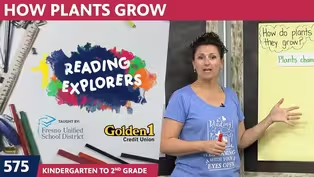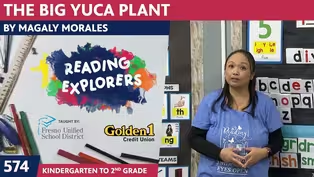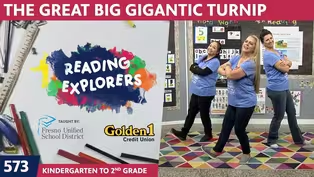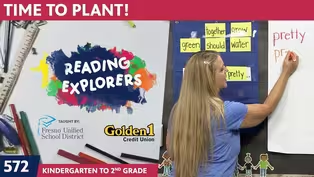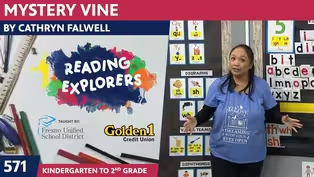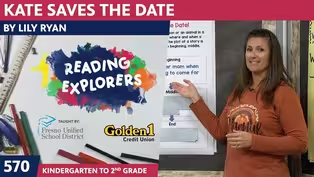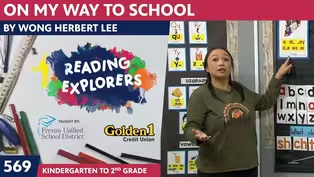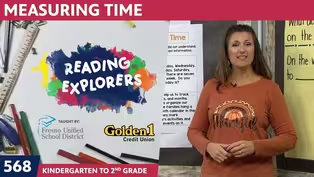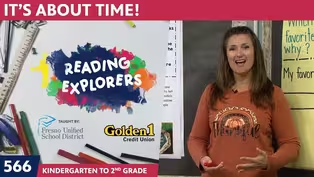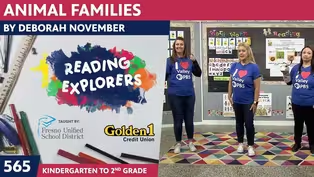
3-323: Keywords 'These' & 'They' and Common Homophones
Season 3 Episode 118 | 14m 13sVideo has Closed Captions
Join Mrs. Nix at Camp Discovery!
Third Grade teacher, Mrs. Nix, welcomes students back to Camp Discovery, a fun learning space packed with reading adventures & fun games!
Problems playing video? | Closed Captioning Feedback
Problems playing video? | Closed Captioning Feedback
Reading Explorers is a local public television program presented by Valley PBS

3-323: Keywords 'These' & 'They' and Common Homophones
Season 3 Episode 118 | 14m 13sVideo has Closed Captions
Third Grade teacher, Mrs. Nix, welcomes students back to Camp Discovery, a fun learning space packed with reading adventures & fun games!
Problems playing video? | Closed Captioning Feedback
How to Watch Reading Explorers
Reading Explorers is available to stream on pbs.org and the free PBS App, available on iPhone, Apple TV, Android TV, Android smartphones, Amazon Fire TV, Amazon Fire Tablet, Roku, Samsung Smart TV, and Vizio.
Providing Support for PBS.org
Learn Moreabout PBS online sponsorshipMore from This Collection
Valley PBS and Fresno Unified School District have partnered with Golden 1 Credit Union to create Reading Explorers Lessons for grades Pre-Kindergarten through Third grade. The daily lessons will be taught by Fresno Unified School District teachers and are created to help students practice their reading skills and reinforce lessons during distance learning.
Video has Closed Captions
Learn about the life cycle of a plant on Reading Explorers. (26m 39s)
K-2-574: The Big Yuca Plant by Magaly Morales
Video has Closed Captions
Join the Reading Explorers as we adventure into a new book The Big Yuca Plant. (26m 30s)
K-2-573: The Great Big Gigantic Turnip
Video has Closed Captions
What will happen at The Great Big Gigantic Turnip? (26m 30s)
K-2-571: Mystery Vine by Cathryn Falwell
Video has Closed Captions
The Bell has rung and the Valley PBS Classroom is open once more. (26m 32s)
K-2-570: Kate Saves The Date by Lily Ryan
Video has Closed Captions
Mrs. Nix, Mrs. Hammack and Mrs. Vang are glad to have you join her for a new day. (26m 32s)
K-2-569: On My Way To School by Wong Herbert Lee
Video has Closed Captions
Mrs. Vang is ready for a new day of phonemic awareness and reading comprehension. (26m 40s)
Video has Closed Captions
We review phonics, frequency words and more on Reading Explorers. (26m 45s)
K-2-567: Nate The Snake Is Late
Video has Closed Captions
What happens when Nate the Snake is late to school? (26m 49s)
Video has Closed Captions
It's time for school! How do you know what time it is? (26m 31s)
K-2-565: Animal Families by Deborah November
Video has Closed Captions
Welcome to the Reading Explorers lessons in the Valley PBS Classroom. (26m 14s)
K-2-564: From Caterpillar To Butterfly
Video has Closed Captions
The transformation from Caterpillar to Butterfly is a special one. (26m 52s)
Providing Support for PBS.org
Learn Moreabout PBS online sponsorship(guitar music) ♪ Good morning to a brand new day ♪ ♪ Time to learn and games to play ♪ ♪ Learning things is so much fun ♪ ♪ Learning is good for everyone ♪ (guitar music) (bright upbeat music) - Good morning, third graders.
My name is Mrs. Nixon, and I am so excited to be here with you on Wednesday morning, as you are preparing yourself to be an amazing thinker, reader and writer.
Again, I'm reading some of my stories all about Abraham Lincoln, because this is our President's week, and I'd love to learn more information about President Lincoln and maybe a little bit about his childhood.
So I encourage you check out some books, you can do that through your local county library, or if you're here in Fresno Unified by visiting Sora.
It's a free app that we have and we love to celebrate reading by kind of cheering on some schools that have been checking out a lot of books here in Fresno.
So in third place for our top schools that are checking out Sora books, we've got Ewing Elementary.
So great job Ewing, that is fantastic that you are continuing to check it out.
Now, how do you get your school up on our poster for the top checkout schools, it's super easy.
Just go on to Sora and check it out.
And then encourage a classmate or two to do the same.
One other thing that I love to point out to you, cause I would love to put one of these in the mail for you.
You're gonna see an address pop up here at the bottom of your screen, and that's gonna be here to PBS and just send me a little card, a little note in the mail, or send me an email, but don't forget to include your return address, and I will put one of these fun activity books for you in the mail.
Now, there are all sorts of different activities you can do.
This one's got a secret code even where you get to figure out what the secret message is.
So lots of fun things to keep your brain engaged and it's totally free.
Let's talk about today.
I've got three things we're gonna go through, we're gonna talk about some homophones, we're gonna talk about some r-controlled syllables, and then we're gonna finish up with some multiple meaning words.
Are you ready to start today?
Excellent.
Let's warm up our brains with those high frequency words.
Now remember, these are words you're gonna come across often in your reading and writing.
So it's important that you not only be able to read them, but to be able to spell them, to write them.
So if you notice that there's one here today, and you think to yourself, I might need to practice that one a little bit more.
That's okay.
Write it down, practice it by the end of the week, you'll have it.
Okay, let's get going.
Let's do this together.
I want you to read these big and loud, lots of practice.
Here we go.
Their, there, then, them, these, they, things, think, this and those.
Excellent.
We have two of them today, we have these, and they.
These are spelled t, h, e, s, e, and they is t, h, e, y, e, y.
So this is a common one I know, especially in third grade that we forget that it's an e y and oftentimes I see it with an a y.
So just remember to think about it as you're writing it.
Help me put these in a couple of sentences.
Read them big and loud with me.
Can you please put hmm on the shelf?
And can hmm come with us to the store?
Can you please put they on the shelf?
No, that doesn't make any sense.
Can you please put these on the shelf?
Excellent.
We don't know exactly what these are, we would need some more context.
But that makes sense.
And can they come with us to the store?
Here we go.
That makes absolute sense, great.
Let's go through and let's talk about some syllabication or doing some syllables.
And one thing that I wanna always talk about when we're doing syllables, one of the rules consists of r-controlled vowels.
So anytime that we have r-controlled vowels, ar, er, ir, or, ur, that r-controlled vowel actually counts together.
It's a new sound and it counts as that vowel sound.
So every syllable, remember has one vowel sound in it.
So let's practice a couple of them here.
So I have the word, person, person.
So thinking to ourselves, how many vowel sounds do we hear?
Well, we hear two of them.
We've got the r-controlled one that I've underlined per, and then we've got son, and so there's our other vowel sound.
So we have person so there are like I said, two vowel, or two syllables.
How about in the word, corner?
Corner.
Now look, this one actually has two r-controlled vowels.
So those are our vowel sounds.
So corner has two syllables, just like that.
Excellent.
Let's switch gears just a little bit.
We're gonna talk about homophones.
Now homophones, every time we say the word homophones, I want you to act like you're picking up your cell phone and you're gonna put that cell phone up to your ear, and what do we do when we're on our phones?
We're listening, and speaking.
So when we put up our homophone, and when we think of the word homophones, and think about this word phone, we're thinking about sounds.
So homophones are words that sound alike, but they're spelled differently and have different meanings.
I have some examples here, I've got the word, write.
There's write, w, r, i, t, e, which means that you're gonna make a mark on a surface, like using a pen on a paper or a pencil or a crayon on a piece of paper.
So you're marking something up, that's to write, and then right, r, i, g, h, t, actually, while yes it's a homophone, it's also a multiple meaning word because it has two different meanings.
Right could mean, yes, you are correct, and it can also refer to the direction such as the opposite of your left, like if you write with your right hand or turn right.
I've got a sentence here and it's gonna use the word right in both spots.
But now we need to figure out which right goes where.
So I will write my name on the right side of the paper, I've got to move this over just a little bit.
I will write my name on the right side of my paper.
So if I'm writing my name, I'm making a mark right?
Correct.
So I will write my name on the right side of the paper.
Excellent job.
Let's go through and let's do a little bit of practice with some with both of those.
So homophones, let's talk about them.
I've got sale and sail, there are two different types.
So thinking about s, a, l, e, maybe that's something you've seen when you've gone into a store and you'll see that things are on sale.
What would this sail, s, a, i, l, has to do with like when you're on a boat.
So let's look, the new sail for our boat was on sale.
So this is that one that we're familiar with the most sale, it means that it was discounted.
So the new sail, those are those big giant white sheets that you see that push the boats along.
That's their sail.
How about road and rode?
This road, is talking about a street and this rode is the past tense, like I rode my bike.
So we rode our bikes down the bumpy road.
So I know that this one is the street, so I'm gonna say r, o, a, d, and we rode is r, o, d, e, we rode our bikes.
Remember what to do with our contractions.
Remember, we're always gonna split it apart.
So it apostrophe s, when we split that apart it says it is.
So its an it's, I don't think it's funny that the puppy chewed its leash.
So I don't think it is funny that the puppy, ah, that works.
So this is the contraction, it is.
We could say it's funny that the puppy chewed its leash, cause that's gonna show its possession.
To and two, we talked about this one a little bit.
This one's talking about directionality and we're going towards something, and two, t, w, o, means the number.
So she needs two dollars to buy the book.
So she needs two, t, w, o, to buy the book.
Excellent job.
Let's look down here.
We're looking for those words with an r-controlled vowels syllable.
We're gonna circle that r-controlled vowel syllable.
So I underline this very first one for us.
This pin has purple ink.
So this is our r-controlled vowel, and where do we see that r-control vowel syllable?
It's gonna be right here, good.
I need lots of water when I run.
Do you see the r-control?
There it is right here.
And what would be our syllable?
Wa ter, good.
And let's do one last one.
We can buy what we need at the market.
Do you see the market?
So Mar ket, right there.
Excellent job.
I wanna switch up gears one last time, and we're gonna finish off today by talking about multiple meaning words.
Now, a multiple meaning word is a word that can mean something entirely different, but it could still be spelled the same and pronounced the same.
So essentially it's the same word, but it has a different meaning.
So let's look.
I've got an example here.
Rose, when we think about the word rose, it could be talking about a flower, like maybe you're gonna give someone roses, and a rose can also mean that something lifted up.
Something the balloon rose up into the sky.
So the word rose.
As we're reading, it's really important that we pay attention and think about what it is that we're reading.
Because it's important that we understand what that word is referencing.
So here is our sentence today using the word rose.
Help me decide which definition is being used here.
Here we go.
The bag was filled with smoke.
This made the balloon lighter than the air.
Because of this, the bag rose into the sky.
So is it talking about a flower?
The bag rose into the air?
No, when we're talking about this rose, we're talking about that it lifted up, that's gonna help us as we're reading, to make sure that we understand what's going on.
It makes that picture for us inside of our mind.
Boys and girls, I just wanna say thank you so much for hanging out with me today.
It was awesome.
We went through, we talked about our homophones those words that sound the same, we talked about r-controlled syllables, and then we finished off with those multiple meaning words.
As you're reading your stuff today, think about it.
Can you find those multiple meaning words?
Can you find some of those homophones as you're reading?
And be thinking about what do those words mean.
So thanks for hanging out with me this morning, as you're getting ready for school, remember, you are responsible for your learning success.
So listen, ask questions and share your ideas because together we can do so much more.
I'll see you tomorrow.
Bye bye.
(guitar music) ♪ Good morning to a brand new day ♪ ♪ Time to learn and games to play♪ ♪ Learning is so much fun ♪ ♪ Learning is good for everyone ♪ (guitar music)
Support for PBS provided by:
Reading Explorers is a local public television program presented by Valley PBS
